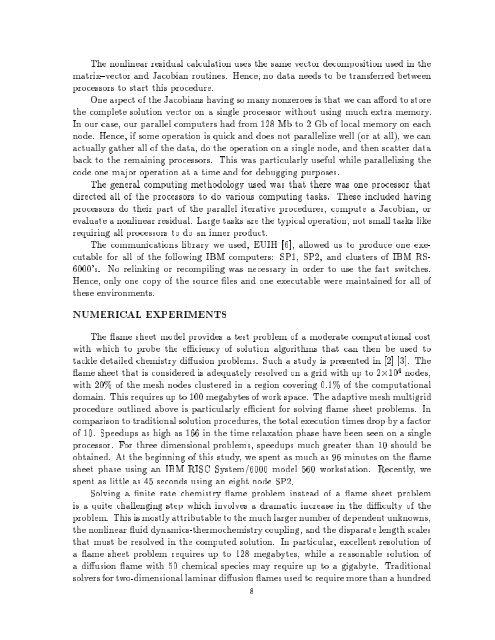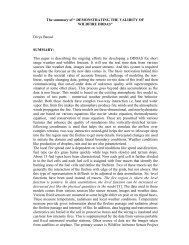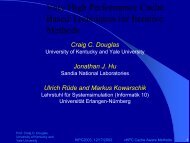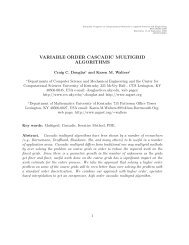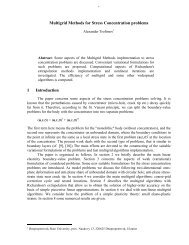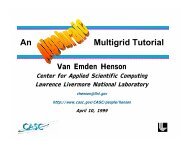numerical simulation of laminar diffusion flames problem ... - MGNet
numerical simulation of laminar diffusion flames problem ... - MGNet
numerical simulation of laminar diffusion flames problem ... - MGNet
Create successful ePaper yourself
Turn your PDF publications into a flip-book with our unique Google optimized e-Paper software.
The nonlinear residual calculation uses the same vector decomposition used in thematrix{vector and Jacobian routines. Hence, no data needs to be transferred betweenprocessors to start this procedure.One aspect <strong>of</strong> the Jacobians having so many nonzeroes is that we can aord to storethe complete solution vector on a single processor without using much extra memory.In our case, our parallel computers had from 128 Mb to 2 Gb <strong>of</strong> local memory on eachnode. Hence, if some operation is quick and does not parallelize well (or at all), we canactually gather all <strong>of</strong> the data, do the operation on a single node, and then scatter databack to the remaining processors. This was particularly useful while parallelizing thecode one major operation at a time and for debugging purposes.The general computing methodology used was that there was one processor thatdirected all <strong>of</strong> the processors to do various computing tasks. These included havingprocessors do their part <strong>of</strong> the parallel iterative procedures, compute a Jacobian, orevaluate a nonlinear residual. Large tasks are the typical operation, not small tasks likerequiring all processors to do an inner product.The communications library we used, EUIH [6], allowed us to produce one executablefor all <strong>of</strong> the following IBM computers: SP1, SP2, and clusters <strong>of</strong> IBM RS-6000's. No relinking or recompiling was necessary in order to use the fast switches.Hence, only one copy <strong>of</strong> the source les and one executable were maintained for all <strong>of</strong>these environments.NUMERICAL EXPERIMENTSThe ame sheet model provides a test <strong>problem</strong> <strong>of</strong> a moderate computational costwith which to probe the eciency <strong>of</strong> solution algorithms that can then be used totackle detailed chemistry diusion <strong>problem</strong>s. Such a study is presented in [2] [3]. Theame sheet that is considered is adequately resolved on a grid with up to 210 4 nodes,with 20% <strong>of</strong> the mesh nodes clustered in a region covering 0.1% <strong>of</strong> the computationaldomain. This requires up to 100 megabytes <strong>of</strong> work space. The adaptive mesh multigridprocedure outlined above is particularly ecient for solving ame sheet <strong>problem</strong>s. Incomparison to traditional solution procedures, the total execution times drop by a factor<strong>of</strong> 10. Speedups as high as 166 in the time relaxation phase have been seen on a singleprocessor. For three dimensional <strong>problem</strong>s, speedups much greater than 10 should beobtained. At the beginning <strong>of</strong> this study, wespentasmuch as96minutes on the amesheet phase using an IBM RISC System/6000 model 560 workstation. Recently, wespent as little as 45 seconds using an eight node SP2.Solving a nite rate chemistry ame <strong>problem</strong> instead <strong>of</strong> a ame sheet <strong>problem</strong>is a quite challenging step which involves a dramatic increase in the diculty <strong>of</strong> the<strong>problem</strong>. This is mostly attributable to the much larger number <strong>of</strong> dependent unknowns,the nonlinear uid dynamics-thermochemistry coupling, and the disparate length scalesthat must be resolved in the computed solution. In particular, excellent resolution <strong>of</strong>a ame sheet <strong>problem</strong> requires up to 128 megabytes, while a reasonable solution <strong>of</strong>a diusion ame with 50 chemical species may require up to a gigabyte. Traditionalsolvers for two-dimensional <strong>laminar</strong> diusion ames used to require more than a hundred8


